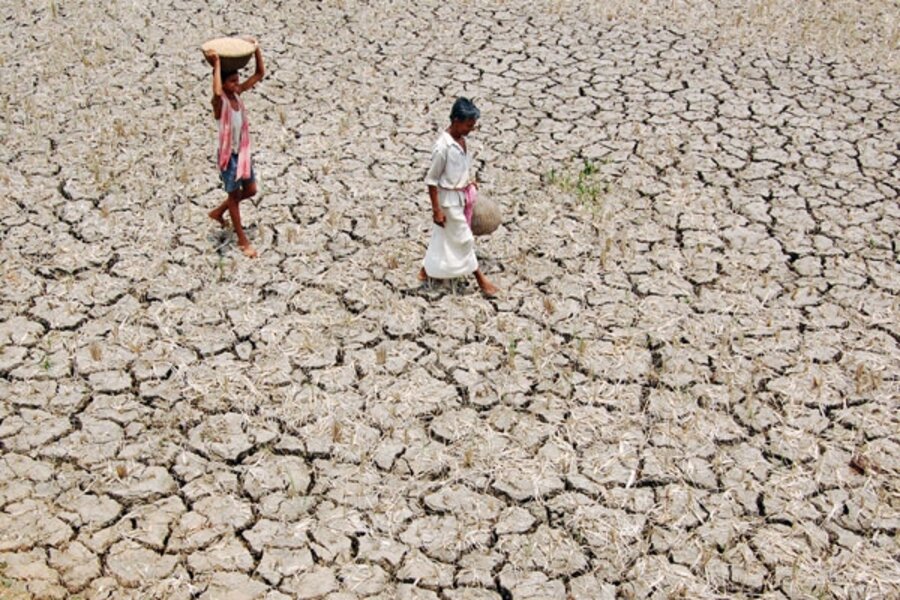India's vanishing groundwater
Loading...
Two new studies suggest that India's aquifers are undergoing rapid depletion due, almost entirely, to water withdrawals for agricultural use. Satellite measurements indicate that the water table is sinking faster than anyone had previously estimated, with potentially dire implications for the 600 million people living regionally — nearly one-tenth of humanity — who rely on it.
One study appears in the journal Nature, the other in the journal Geophysical Research Letters.
From the Nature study press release:
Using satellite data, UC Irvine and NASA hydrologists have found that groundwater beneath northern India has been receding by as much as 1 foot per year over the past decade – and they believe human consumption is almost entirely to blame. More than 109 cubic kilometers (26 cubic miles) of groundwater disappeared from the region's aquifers between 2002 and 2008 – double the capacity of India's largest surface-water reservoir, the Upper Wainganga, and triple that of Lake Mead, the largest manmade reservoir in the U.S.
Surface water percolating down from rain, snow, lakes, and rivers recharges aquifers. Some aquifers contain water that's thousands to millions of years old. (According to New Scientist, the world's oldest aquifer lies beneath the Sahara — rain that fell perhaps 1 million years ago.)
How does this bode for India's agriculture? NASA's Matt Rodell, lead author on the Nature study, says: "If measures are not soon taken to ensure sustainable groundwater usage, consequences for the 114 million residents of the region may include a collapse of agricultural output, severe shortages of potable water, conflict, and suffering."
During the second half of the 20th century, water withdrawals increased dramatically. Beginning in the 1960s — the Green Revolution — the Indian government instituted policies meant to boost agricultural production. As a result, the amount of irrigated land in India nearly tripled between 1970 and 1999. In northern India, agriculture is responsible for up to 95 percent of groundwater use.
Science News says of the study reported in Geophysical Research Letters:
In the mid-1990s, India’s Central Ground Water Board estimated that farmers pulled more than 172 cubic kilometers of water each year from aquifers in the study region of northeastern India, southern Nepal and western Bangladesh.... That’s more than three times the volume of India’s largest surface reservoir. New data gleaned from gravity-measuring satellites suggest that the annual rate of extraction in that region has jumped more than 60 percent since then.
The Science News article continues:
The pace of groundwater depletion in northern India is greater than anyone expected and mirrors trends seen in many other regions, including China and the western United States, says Sandra Postel, director of the Global Water Policy Project, based in Los Lunas, N.M. When groundwater disappears or becomes too difficult to pump, people who now support themselves on the land will become economic refugees, she contends. In many parts of the world, Postel adds, “water problems are becoming very serious, very fast.”
The AFP reports that 80 percent of India is threatened with drought this year. The region is experiencing a weak monsoon season. Monsoons bring rainfall to the area on a fairly predictable schedule. (A rough rule of thumb: When we have El Niño years off the US West Coast, as we're having this year, the other side of the Pacific tends to have weaker-than-usual monsoons.)
But India's prime minister, Manmohan Singh, says that, after two years of good harvest, grain stores were adequate to stave off famine brought on by crop failures.
Bloomberg News gives some context to the issue of water groundwater withdrawals worldwide. Forecasts aren't cheery:
About a fifth of water used globally comes from under the ground, the Stockholm International Water Institute has said. Withdrawals are predicted to increase 50 percent by 2025 in developing countries, and 18 percent in developed countries, according to the policy group based in the Swedish capital.
But how do we know what's happening to India's underground water supply anyway? By definition, you can't see it, and we have little to no on-the-ground data.
The answer: Gravity. Scientists infer groundwater levels from variations in Earth's gravitational field measured by satellites.
Richard Kerr of Science Now explains how it works:
As the lead spacecraft passes over a patch of anomalously strong gravity, it accelerates ahead of the trailing spacecraft. Once past the anomaly, the lead satellite slows back down. Then the trailing spacecraft accelerates and again closes on the leader. By making repeated passes over the same spot, GRACE [the Gravity Recovery and Climate Experiment satellite mission] measures changes in Earth's gravity, which are mainly due to water moving on and under the surface. Most famously, GRACE has recorded the shrinking of ice sheets; it has also detected shifting ocean currents, the desiccation of droughts, and the draining of large lakes. Outside of wasting ice sheets, the world's largest broad-scale decline in gravity during GRACE's first 6 years came across a 2.7-million-square-kilometer, east-west swath centered on New Delhi.
Of the gravity-measuring method, Jay Famiglietti, associate professor of earth system science at the University of California, Irvine, and co-author on the Nature study, tells Bloomberg:
“This is the first time that we have been able to go into the region with essentially no data on the ground and be able to come up with a pretty reasonable number for the rate of groundwater depletion.”





